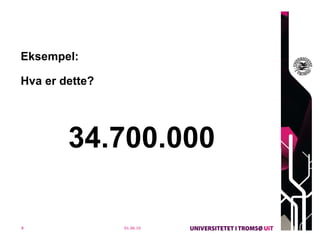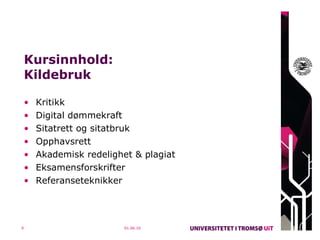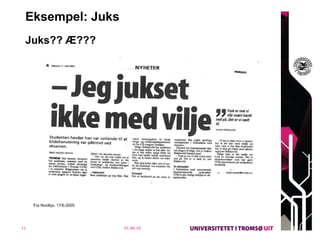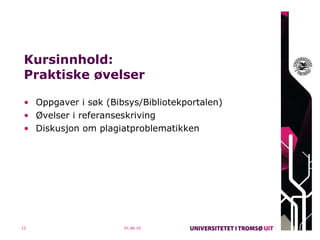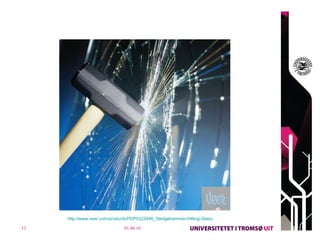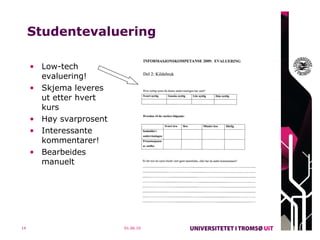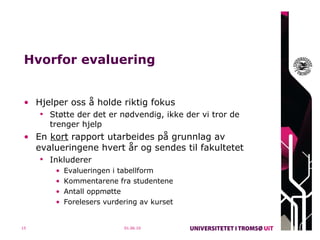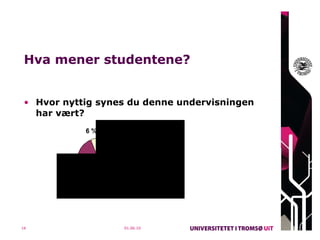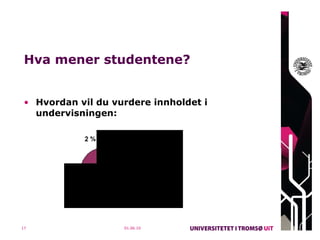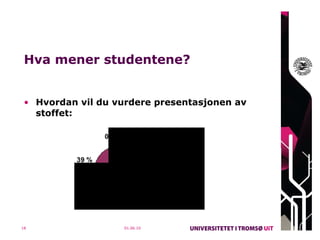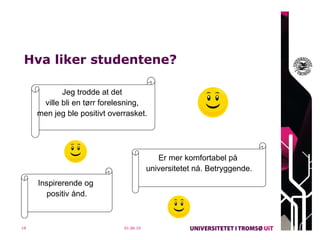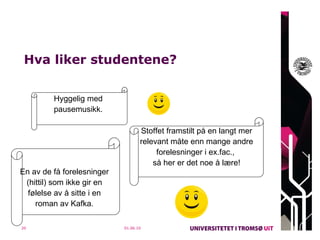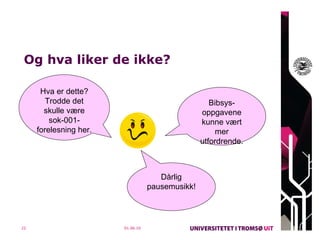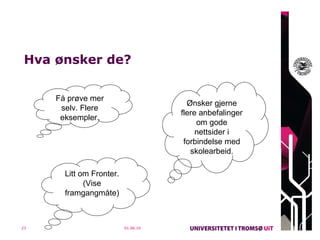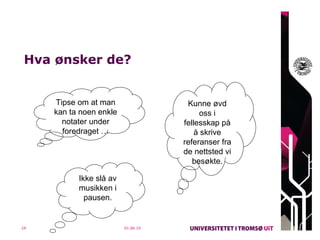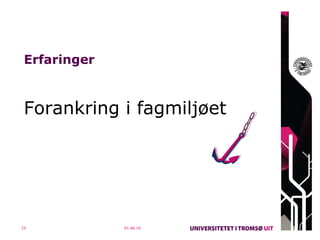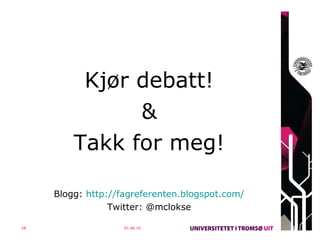Fagrefkonf 2010 lokse
- 1. ” … men jeg ble positivt overrasket” Undervisning i informasjonskompetanse: Hva gjør vi og hva synes studentene? Mariann Løkse Universitetsbiblioteket i Tromsø [email_address]
- 2. Innhold Våre kurs Studentevaluering Erfaringer 01.06.10
- 3. Våre kurstyper Brukeropplæring Informasjonskompetanse 01.06.10
- 4. INF#¤MASJ&%@KOMPETA£¤E What's in a name? That which we call a rose By any other name would smell as sweet. Romeo and Juliet (II, ii, 45-46) 01.06.10
- 5. Et kurs i akademisk overlevelsesteknikk For hvem? Alle nye studenter på HSL-fakultet Av hvem? Fagreferenter Omfang? 3 x 2 timer 01.06.10
- 6. Kursinnhold: Informasjonss√∏king Informasjon om bibliotekets tjenester Bibsys + Ofelas (bibliotekportalen) VPN ≥ß√∏∞Ïeprosessen Studieteknikk & l√¶ring p√• universitetet Spr√•kbruk Henvisning til VIKO og ≥ß√∏∞Ï & skriv 01.06.10
- 7. Eksempel: Born digital = born information literate?Ã˝ Ã˝ ‚Äù students may be adept at using new technologies, but they do not necessarily have the abilities to use research content in effective ways‚Äù (p.9) Ã˝ Ã˝ Hampton-Reeves, S, et al. ‚ÄùStudents use of research content in teaching and learning.Ã˝ A report for the Joint Information Systems Couoncil (JISC)‚Äù 2009. http://www.jisc.ac.uk/media/documents/aboutus/workinggroups/studentsuseresearchcontent.pdf [Accessed 04.08.2009] 01.06.10
- 8. Eksempel: Hva er dette? 34.700.000Ã˝ Ã˝ 01.06.10
- 9. Kursinnhold: Kildebruk Kritikk Digital d√∏mmekraft Sitatrett og sitatbruk Opphavsrett Akademisk redelighet & plagiat Eksamensforskrifter Referanseteknikker 01.06.10
- 10. Eksempel: Kildekritikk Ting er ikke alltid det de gir seg ut for å være…. 01.06.10 Begge bilder er hentet fra Worth1000.com: http://fx.worth1000.com/contests/6089/hybrid-produce-3/
- 11. Eksempel: Juks Juks?? Æ??? Fra Nordlys, 17/6-2005 01.06.10
- 12. Kursinnhold: Praktiske √∏velser Oppgaver i s√∏k (Bibsys/Bibliotekportalen) √òvelser i referanseskriving Diskusjon om plagiatproblematikken 01.06.10
- 14. Studentevaluering Low-tech evaluering! Skjema leveres ut etter hvert kurs H√∏y svarprosent Interessante kommentarer! Bearbeides manuelt 01.06.10
- 15. Hvorfor evaluering Hjelper oss å holde riktig fokus Støtte der det er nødvendig, ikke der vi tror de trenger hjelp En kort rapport utarbeides på grunnlag av evalueringene hvert år og sendes til fakultetet Inkluderer Evalueringen i tabellform Kommentarene fra studentene Antall oppmøtte Forelesers vurdering av kurset 01.06.10
- 16. Hva mener studentene? Hvor nyttig synes du denne undervisningen har vært? 01.06.10
- 17. Hva mener studentene? Hvordan vil du vurdere innholdet i undervisningen: 01.06.10
- 18. Hva mener studentene? Hvordan vil du vurdere presentasjonen av stoffet: 01.06.10
- 19. Hva liker studentene? 01.06.10 Jeg trodde at det ville bli en tørr forelesning, men jeg ble positivt overrasket. Er mer komfortabel på universitetet nå. Betryggende. Inspirerende og positiv ånd.
- 20. Hva liker studentene? 01.06.10 Hyggelig med pausemusikk. Stoffet framstilt på en langt mer relevant måte enn mange andre forelesninger i ex.fac., så her er det noe å lære! En av de få forelesninger (hittil) som ikke gir en følelse av å sitte i en roman av Kafka.
- 21. Og hva liker de ikke? 01.06.10 Kunne med fordel brukt litt mindre tid på informasjon om biblioteket. Jeg er ganske lei av PowerPoint-presentasjoner! Klarer ikke å henge med i alt, er ikke kjent med bibliotekterminologi. Stusser for eksempel over ’tidsskrift’ og ’database’, helt enkle ord jeg ikke klarer helt å plassere.
- 22. Og hva liker de ikke? 01.06.10 Bibsys-oppgavene kunne vært mer utfordrende. Hva er dette? Trodde det skulle være sok-001-forelesning her. Dårlig pausemusikk!
- 23. Hva ønsker de? 01.06.10 Få prøve mer selv. Flere eksempler. Ønsker gjerne flere anbefalinger om gode nettsider i forbindelse med skolearbeid. Litt om Fronter. (Vise framgangmåte)
- 24. Hva ønsker de? 01.06.10 Tipse om at man kan ta noen enkle notater under foredraget … Kunne øvd oss i fellesskap på å skrive referanser fra de nettsted vi besøkte. Ikke slå av musikken i pausen.
- 25. Erfaringer Forankring i fagmilj√∏et 01.06.10
- 26. Erfaringer N√∏dvendig √• v√¶re med p√• planleggingen V√¶r tidlig ute! Timeplanene for h√∏sten fastsettes ofte i mars.Ã˝ Biblioteket b√∏r v√¶re representert i arbeidsgrupper/emnestyrer etc. som planlegger tilbudet. Fagmilj√∏et har stor betydning for oppm√∏teprosenten p√• kursene v√•re Informasjonsflyten mellom bibliotek - studenter - fagmilj√∏ m√• v√¶re god 01.06.10
- 27. Utfordringer Hvordan kan vi: Forbedre samarbeidet med fagmilj√∏/integrering av kursene i √∏vrig studietilbud? Forbedre oppm√∏teprosenten? Forbedre informasjonsflyten fra biblioteket til studenter/fagmilj√∏? Holde et h√∏yt faglig og pedagogisk niv√• p√• undervisningen? Forbedre samkj√∏ring/utveksling av informasjon, b√•de internt p√• biblioteket og med andre bibliotek? Ã˝ Ã˝Ã˝Ã˝ 01.06.10
- 28. Kj√∏r debatt! & Takk for meg! Blogg: http://fagreferenten.blogspot.com/ Twitter: @mclokse 01.06.10

![” … men jeg ble positivt overrasket” Undervisning i informasjonskompetanse: Hva gjør vi og hva synes studentene? Mariann Løkse Universitetsbiblioteket i Tromsø [email_address]](https://image.slidesharecdn.com/fagrefkonf2010lokse-100601050244-phpapp02/85/Fagrefkonf-2010-lokse-1-320.jpg)
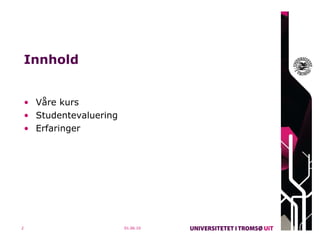
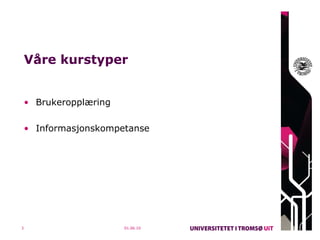
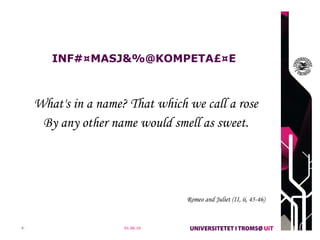
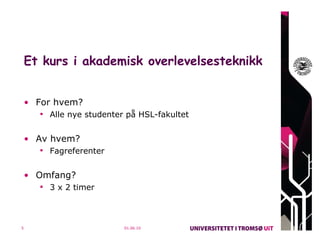
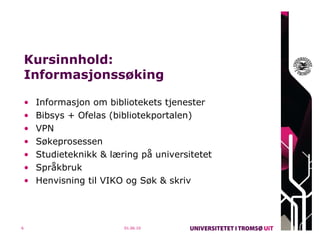
![Eksempel: Born digital = born information literate?Ã˝ Ã˝ ‚Äù students may be adept at using new technologies, but they do not necessarily have the abilities to use research content in effective ways‚Äù (p.9) Ã˝ Ã˝ Hampton-Reeves, S, et al. ‚ÄùStudents use of research content in teaching and learning.Ã˝ A report for the Joint Information Systems Couoncil (JISC)‚Äù 2009. http://www.jisc.ac.uk/media/documents/aboutus/workinggroups/studentsuseresearchcontent.pdf [Accessed 04.08.2009] 01.06.10](https://image.slidesharecdn.com/fagrefkonf2010lokse-100601050244-phpapp02/85/Fagrefkonf-2010-lokse-7-320.jpg)
